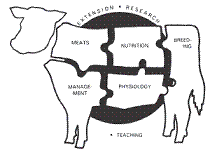Animal Science, Department of

Nebraska Beef Cattle Reports
Date of this Version
January 1996
Abstract
When compared to an all concentrate diet, roughage addition (5 to 15% of diet DM) stimulates intake, chewing, rumination and possibly particulate and liquid outflow from the rumen. Roughage addition. therefore. reduces acidosis by diluting concentrate intake and/ or increasing salivation and buffering capacity of the rumen.
Alfalfa hay is a commonly fed roughage source. If the use of the fiber fraction within alfalfa roughage is to simply dilute concentrate intake and help prevent acidosis, then any fiber source fed at a similar NDF level should respond similarly to alfalfa hay.
Particle size plays a major role in determining ruminal retention time. The smaller the particle size the faster the passage rate from the rumen. If roughage added to a finishing diet consists of small particles, then the dilution effect desired from roughage addition to finishing diets may be negligible. However, if roughage particle size is too large, total intake and energy consumed may decrease due to an increase in ruminal retention. Objectives of our research were to evaluate the effect of alfalfa hay and wheat straw with differing particle sizes on performance of steers fed a high-concentrate finishing diet.


Comments
Published in 1996 Nebraska Beef Cattle Report; published by Agricultural Research Division, Institute of Agriculture and Natural Resources, University of Nebraska-Lincoln.